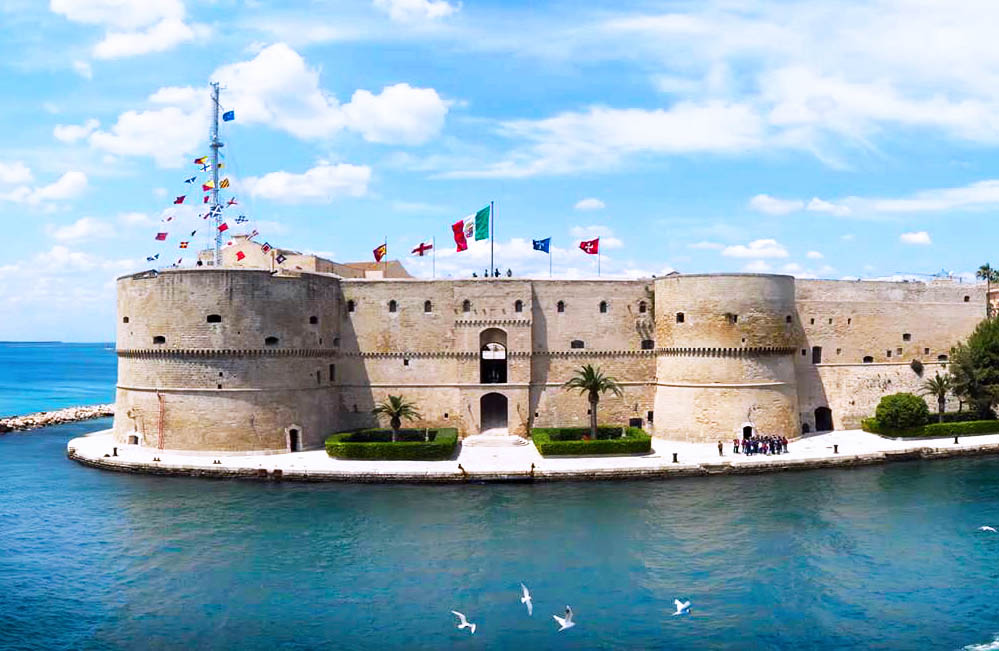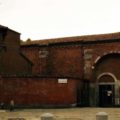Within the region of Puglia lies the Province of Taranto. For thousands of years, the province’s capital city of the same name has been an important port. It has made the city one of the most important shipping and military harbors on the Ionian Sea. It is no surprise that as industry evolved within the area, maritime trades, steel works, iron foundries and military shipyards became the most dominant industries. Yet for all of its modern and impressive facilities, the ancient culture and rich traditions of Taranto are ever present. Additionally, it was the fantastic weather as well as the natural harbor that brought colonists to the area over 2,700 years ago. Visitors can still see some of the architectural remains today.
Over the centuries, the fortunes of Taranto have fluctuated, but the city has seen a great resurgence in recent decades. It is an ideal tourist destination, offering a fantastic range of ancient buildings, monuments and beautiful white sandy beaches.
The coast of the Province spans over 87 miles. There is a diverse and beautiful natural landscape comprised of wild areas with sheer cliffs and long stretches of sandy beaches that blend with the deep vibrant blue sea. Rolling hills, wide valleys and rocky areas also make up the landscape. The characteristic villages are ancient and the isolated farms and caves are a sign of ancient dwellings. In many areas, the famous trulli, typical cone-shaped buildings are visible. Many farmhouses have been restored and today accommodate important farming and winery activities, attesting to the area’s ancient tradition of producing excellent products, such as olive oil and wine.
Taranto is known as “The City of Two Seas.” Located on a piece of land that separates the open sea, it divides what are known as Mar Grande and Mar Piccolo. The artificial channel that connects them is surmounted by the famous Swing Bridge, beyond which lies the heart of old Taranto, an ancient medieval town with numerous places that recount its ancient origins.
Undoubtedly, one of the finest sights in Taranto is the Aragonese Castle. It stands in the southeast corner of the island of Borgo Antico and can be seen when entering the bay surrounding the city. Parts of the castle actually date back to the 10th century. The main walls and towers that stand today were primarily constructed in the late 1400s by Ferdinand II of Aragon. Entering the castle by way of its raised walkway allows a stroll across the battlements and towers, with a view across to the sea and the Isle of Saint Peter in the distance. Furthermore, the magnificent Chapel of St. Leonard is located within the castle walls and is a must see while visiting.
The old town of Taranto can be easily navigated on foot and makes for a fascinating walking tour. One of the ancient structures that you will come across in the center of town is the Cathedral of San Cataldo. It was built during the 10th century, with additions made over the course of the next two hundred years. The front facade features ornate marble statues and decorative pediments, with the famous coat of arms of Taranto (a scorpion) seen above the immense doorway. Inside, the Byzantine influence of the Eastern Roman Empire is unmistakable. The Chapel of San Cataldo features some amazing decoration and patterned artwork, with a dazzling display of color, while in other parts of the Cathedral you can still see some of the original mosaic floor tiles.
It may be “The City of Two Seas,” but Taranto is also a city with two faces. Beyond the Swing Bridge, the modern side of Taranto has developed around what had been a 19th century village facing the waterway. There you will find the former Convent of San Pasquale Alcantarini, which now houses the National Archaeological Museum, famous for its rich collection of rare finds.
Along the coast are lovely places to enjoy a relaxing vacation, whether diving into the crystal blue waters of the Ionian Sea or simply enjoying the sun while lying on the white sand. In the coastal town of Marina di Pulsano, low cliffs, white inlets and clear waters offer visitors a truly beautiful landscape. To the south of the provincial capital, Marina di Leporano is perfect for those who prefer a jagged coastline with cliffs interrupted by small sandy beaches.
In Massafra, the Ravines of San Marco and La Scala are a dense network of paths, slopes, caves and places of worship, around which the modern part of the town was built. The Ravine of Laterza, seven and a half miles long, is of considerable size and historical importance, as evidenced by the ancient origins of the town. The ancient village of Grottaglie dates back to the first century AD and is famous around the world for its handmade pottery, a craft rooted in centuries past.
It was the local farms of Taranto that spearheaded the agricultural development of the area in the Middle Ages. Although you will find farms throughout the region of Puglia, in the area of Crispiano you will find several dozen, earning it the nickname the city of 100 farms. North of Taranto is Martina Franca, a charming town that overlooks the Itria Valley. Its lush green nature contrasts with the white trulli and ancient farms that frame the old town’s Baroque architecture.
The desire to rediscover the historical significance and handiwork of the Province has grown significantly in recent years. Hence, routes dedicated to experiencing the authentic flavors and traditional crafts of the Taranto Province has grown substantially in popularity. Along these routes, literal ‘paths of tourism,’ one may enjoy fine wines and extraordinary olive oils, in addition to the creative arts, such as ceramics, that have made the area famous.
The many landscapes offer the possibility of organizing interesting excursions. Lovers of photography and birdwatching will enjoy the Lake of Salinella near Marina Ginosa, home to a rich variety of wildlife and birds, while golf enthusiasts can find ideal places to play in the beautiful scenery of Riva dei Tessali.
For those who ‘travel on their stomachs’ the gastronomy of the province is characterized by both the land and sea. Mussels and oysters, the pride of Taranto, can be tasted along with pasta made from the world’s finest durum wheat. Local crops provide excellent starting points for dishes based on vegetables and beans and do not fail to experience the delicious cheeses and sausages of the Province, notably burrata cheese and capocollo sausage. Finally, a wide variety of sweet fruits round out the menu, including grapes, oranges and the famous clementines of the Gulf of Taranto. These flavors pair wonderfully with the excellent wines of the province, such as the Primitivo di Manduria, the Martina Franca and the Lizzano. With history, beauty, fine foods and wines, what more can one ask for than the splendors of the Province of Taranto?





